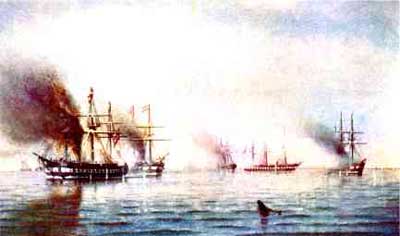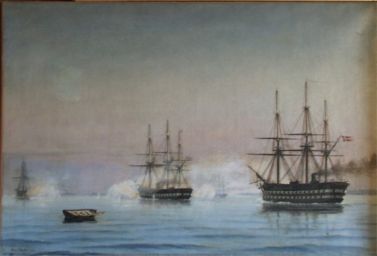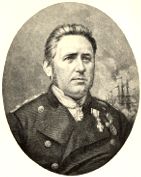|
You are here: 4Campaigns & Battles4Index4The 2nd Schleswig War |
|||||||||||||||||||||||||||||||||||||||||||||||||||||||||||||
|
2nd Schleswig War (1864):
March 17, 1864, the Prussian navy made an attempt to break the
Danish naval blockade. The attempt failed.
Triumph at sea
|
||||||||||||||||||||||||||||||||||||||||||||||||||||||||||||
|
Model of the steam-propelled frigate
NIELS JUEL. |
The steam-propelled frigate NIELS JUEL, Commander Johan L. Gottlieb, had since the end of January been stationed in the Skagerrak in order to look out for 3 Prussian gunboats supposed to be in the North Sea. This however proved not to be the case at present. February 3, the NIELS JUEL was ordered to the waters between Borkum and Heligoland. Shortly after NIELS JUEL was ordered to proceed through the English Channel |
and extend the operational area as far as Falmouth.
The orders were still to look out for possible Prussian men of war, and at the same time seize any German merchant ship found at sea.
Big Fear among German Ship owners
The presence of the Danish Frigate in the English Channel caused a big fear among the German ship owners. The fear of capture of their ships was big.
Underwriters in Hamburg had hired a steamship, which cruised the Channel, in order to warn German ships of the presence of the Danish man-of-war.
The German insurance Company had furthermore promised a reward of £ 3 Sterling, to any English pilot who warned a German ship of the Danish presence in the area from the Channel to Heligoland.
Weather in the North Sea at this time of the year was rough, and in mid March the frigate had to return to Copenhagen with damages and was replaced by the propeller corvette DAGMAR, but soon it was shown that the Danish naval blockade was as efficient as under the 1st Schleswig War 1848-50.
First Action
As soon as mid March the Navy was engaged in its first combat, it was the new armored monitor ROLF KRAKE that delivered the navy's first contribution to this war.
February 18, just one week after the ship had left Copenhagen, its two rotating turrets, each with 2 smoothbore 60 pounders, would be fired in anger.
ROLF KRAKE was ordered to shell a bridge, which the Prussians had build at the mouth of Nybøl Nor.
In order to carry out this order, the ROLF KRAKE headed up through Flensburg Fjord, and at level with Egernsund a heavy indirect fire was directed on the bridge. Because of shallow waters the ship was not able to get as close as to shoot in direct line of sight.
During one and a half hour 57 shells were fired and the ROLF KRAKE herself receiving heavy fire, it was then decided to return to Sonderborg.
The ship had been hit approximately 100 times and had 3 wounded in the ships company. The Prussian artillery had however not succeeded to penetrate the armored monitor ROLF KRAKE, in spite of the Prussian fire being from a distance of only 1,400 to 2,000 meter.
-1559-1981.jpg)
The armored monitor ROLF KRAKE.
Battle at Rügen
On March 17, 1864, Prussian naval forces attempted to break the Danish naval blockade. The corvettes ARCONA and NYMPHE departed Swinemünde on an easterly course to investigate whether any Danish ships were around.
As no Danish presence was realized at first, the Prussian ships changed to a westerly course and was reinforced by the paddelwheeler LORELEY and 6 steam gunboats.
Then the combined Prussian squadron headed north in line abreast. As it was level with Jasmund the Danish force, sighted the Prussian squadron.
The Danish force consisted of the propeller frigate SJÆLLAND, the ship of the line SKJOLD, as well as the 2 corvettes THOR and HEJMDAL and was commanded by Rear Admiral C. E. van Dockum. This force was shortly afterwards reinforced by the propeller frigate TORDENSKJOLD.
When sighting the enemy, the Danish force immediately weighed anchor and headed south directly against the Prussian squadron. Shortly afterwards there was a fierce exchange of fire between the two sides without any serious damage on either side.
After less than one and a half hour the Prussian squadron withdrew south. The Danish force did not succeed in cutting off their retreat.
Never the less the Prussians did not manage to break the blockade, but the incident meant that the Danish Navy still had to maintain a large presence for continued blockade.
New Threat from South
In order to protect the German merchant fleet against the total Danish blockade Austria, Prussia’s ally in the German Bund, decided to send a larger naval force from the Mediterranean to the North Sea, with the purpose of breaking the Danish blockade.
As early as March 1864, the Danish Naval Ministry had received intelligence that the Austrians were preparing the transfer of this naval force to Danish waters.
This had the effect that the ministry immediately decided to form a North Sea squadron.
Commander Eduard Suenson was given this command and used the frigate NIELS JUEL as flagship. The squadron furthermore consisted of the propeller corvettes DAGMAR and HEJMDAL.
On April 21, the squadron took station in the North Sea to counteract the new threat from south.
The frigate JYLLAND reinforced the North Sea squadron later. For inscrutable reasons the corvette DAGMAR was ordered to leave the squadron for other assignments.
The Battle for Als
At 3 o'clock in the morning of March 28, 1864, the Prussian troops launched the first assault on the Danish positions, at the crest of Dybbøl.
At the first sign of dawn the armored monitor ROLF KRAKE left Sonderborg and headed into the northern part of Vemmingbund. It was immediately taken under fire by the Prussian field artillery, on the high ground of Broager.
The ship received several hits, but chose not to return fire. It continued to the gorge in front of the two Danish entrenchments (I & II) where she opened fire against the advancing Prussian troops.
From the ROLF KRAKE it was plain what was going on ashore, the CO, Commander Rothe, immediately decided to proceed to Vemmingbund, even though he had not yet received the agreed signal.
The advancing enemy columns were immediately taken under fire, and the ROLF KRAKE herself also being subjected to heavy enemy fire.
In spite of receiving countless hits, the ship did succeed to cause disruption in the Prussian advance, by firing a total of 95 shells at the Prussian right flank, which caused this to be thrown back in this sector.
But the efforts of the ROLF KRAKE alone could not cause a decisive influence on the land battle. And when the Danish troops around mid day had been forced back towards Sonderborg, Commander Rothe decided to keep out of range of the Prussian artillery.
Battle at Heligoland
On May 6, the North Sea squadron consisting of the frigates NIELS JUEL and JYLLAND as well as the corvette HEJMDAL headed south in order to resume the blockade.
From several sources it had now been confirmed that the Austrian squadron under command of Captain Tegetthoff already had arrived in these waters and united with 3 Prussian gunboats at Texel.
The amalgamated Austrian-Prussian squadron had now taken station in Cuxhafen.
On the morning of May 9, this amalgamated squadron headed north in line ahead to meet the Danish squadron.

The burning Austrian frigate
SCHWARZENBERG (left)
heave to escape after being seriously hit, while the RADETZKY tries to
cover the serious damaged frigate.
(Painting by Lieutenant H. J. Marcher)
The relative strength between the two squadrons was almost equal, however the Austrian guns in several ways were slightly superior to those of the Danes.
At 1345 the Austrian frigate SCHWARZENBERG opened fire on the Danish ships at a range of 3,700 meters, but not until the range was far less did Suenson give the order to open fire.
A fierce combat now took place. The decisive moment came when at 1530 a shell exploded inside SCHWARZENBERG. The effects of the damage forced the Austrians to break off the engagement, and seek refuge on neutral English territory off Heligoland.
The Danish squadron did not get a chance to cut off the enemy retreat as the English frigate AURORA cut in between.
Thus the mauled Austrian-Prussian squadron under cover of darkness managed to reach Cuxhafen without interference from the Danish squadron.
This was to be Denmark's last sea battle where ships fought directly against ships.
Negotiations in London
On English initiative negotiations had begun as early as April 25 . This was the so-called "London Conference". All the parties of the war participated. Various partitions of Schleswig were discussed, without there being any agreement.
Probably as a result of the Danish victory at Heligoland May 9, a ceasefire was agreed upon from May 12.
On June 20, 1864 there was a breakdown of negotiations, as the Danes stood firm on the demand for a Danish border at "Dannevirke" – a solution that neither Prussia nor Austria could accept.
Neither would Denmark accept that the drawing of the border should be made by arbitration, which would mean that foreign powers should draw the future border.
Ceasefire expires
June 26, the ceasefire had hardly expired before the Prussians at 2 o'clock in the morning started attacking across the sound between Jutland and the island of Als by means of storm boats.
The armored monitor ROLF KRAKE reached the northern end of the sound at 3 o'clock in the morning.
From the ship it could be seen that the sound was filled with small boats plying back and forth across the sound.
ROLF KRAKE immediately open fire on the many boats. First fire were grapeshot's, but soon after shells were used.
The hefty fire from the battery ship spread death and devastation among the small boats in the sound. Many boats were scattered and tried to reach shore on whatever side of Alssund, and the transfer of troops temporarily brought to a stop.
On board the ROLF KRAKE however, there was no clear view of the military situation ashore, or any idea of how many troops the Prussians had managed to transfer.
For some time the ship kept her station in Augustenborg Fjord not receiving the vital information and repeatedly being hit by enemy fire, Commander Rothe decided, according to his instructions, to round the island and assist with the possible embarkation/evacuation of troops from Als.
North Sea Islands given up as the last Bastion
|
Lieutenant Commander |
On the North Sea islands, a small force under command of Lieutenant Commander O. C. Hammer, had managed to keep the islands free of enemy landings, until the day before the end of hostilities . The force consisted of two small armed steamships, 8 gun boats, a number of customs boats and a company of soldiers. During the entire war a number of attempts of rebellion had been warded off. However the position on the islands was seriously worsened when the Danish North Sea squadron left the North Sea after the battle of Heligoland. Hammer had up to this time been able to concentrate on defense against attacks from the land side, but was now encircled. |
June 11, the Austrian navy was back in the bay of Heligoland and blocked the islands from the sea.
An Austrian attempt to attack the island of Sylt from the sea was thwarted by Danish gun boats. In the longer term however, the situation was no longer tenable, consequently Hammer surrendered on June 19 - just one day before the ceasefire.
Having completed the destruction of his gunboats. All the islands were thereupon occupied by the enemy, except the northernmost island, Fanø.
Peace – But Southern Jutland lost
Until the ceasefire between Denmark and Prussia – Austria was signed on June 20, the armored monitor ROLF KRAKE together with the armored schooner ESBERN SNARE and others, continued to patrol the waters between Als and Funen.
At the peace negotiations in Vienna, Denmark received an ultimatum that implied that the counties of Schleswig, Holstein and Lauenburg should be surrendered to Prussia and Austria in unison.
|
Sources: |
||
|
& |
Danmarks Søkrigshistorie, by Kay Jungersen, published on behalf of the Naval Academy, Centraltrykkeriet, Copenhagen, 1945. |
|
|
& |
Dansk Udenrigspolitiks Historie, Vol. 3 - Fra Helstat til Nationalstat, by Claus Bjørn & Carsten Due-Nielsen, editor: Carsten Due-Nielsen, Ole Feldbæk & Nikolaj Petersen, Gyldendals Leksikon, Copenhagen 2003 (ISBN-7789-91-4) |
|
|
& |
Den Anden Slesvigske Krig 1864, by Colonel N. P. Jensen, Det Nordiske Forlag, Copenhagen 1900 |
|
|
& |
Flåden gennem 450 år, editor Commander s.g. R. Steen Steensen, Martins Forlag, 2. edition, Copenhagen, 1970 (ISBN87-566-0009-7) |
|
|
& |
Håndbog i Nordens Søkrigshistorie, by Lieutenant Cai Baron Schaffalitzky de Muckadell, Copenhagen 1911 |
|
|
& |
Officerer i den
Dansk-Norske Søetat 1660-1814 og den Danske Søetat 1814-1932, Vol. I og II,
by Th.
A. Topsøe- |
|
|
& |
Vor Flaade i Fortid og Nutid, Vol. I and II, by Halfdan Barfod, Nordiske Landes Bogforlag, Fredericia, 1942 |
|
|
& |
Vor sidste kamp for Sønderjylland, by Axel Liljefalk and |
|
|
& |
Vor Sømagts Historie, by O. Eidem and O. Lütken, Det Nordiske forlag, Copenhagen, 1905. |
|
|
44You are also referred to the Naval Bibliography |
||
![]()
- Do you miss a major event on this Site,
or do you hold a great story?
Are you able to contribute to the unfolding of
the Danish Naval History,
please
e-mail
me, enclosures are welcome.
Please remember to list your sources.
You can also use the Naval Web Forum on this web-site.
![]()
|
MORE IN-DEPTH STORIES FROM |
|
The Battle for Als (1864) - The Battle off Heligoland (1864) |
|
THE TOPIC STORIES: |
|
- Wars against England (1801-1814) - Reconstructing the Navy (1814-1848) - The 1st Schleswig War (1848-50) - The interim War Years (1850-64) - The 2nd Schleswig War (1864) - The long Period of Peace (1864-1914) - The Navy during the 1st World War (1914-1918) - The Interim Years (1919-1939) - The Navy during the 2nd World War (1939-1945) - The Cold War Period (1945-1989) - |
|
SEE ALSO: |
|
- |
-
This page was last updated: -
This page was first published: April 20, 2004
Copyright © 2013-2016 Johnny E. Balsved - All rights reserved - Privacy Policy



.jpg)
